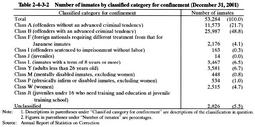| Previous Next Index Image Index Year Selection | |
|
|
1 Basic systems for treatment The essence of treatment of inmates in penal institutions lies in providing correctional treatment through the execution of the sentence and aiming for the reform and social rehabilitation of the inmates. There are 2 basic systems of treatment of inmates: the Classification Treatment System, under which scientific surveys are conducted to identify the problems of individual inmates, groups of inmates are organized based on the results of such surveys, and effective treatment is carried out in accordance with the nature of each group; the Progressive Treatment System, under which 4 grades (Grades 1 to 4) have been established within the process of execution of the sentence, and inmates progress gradually from the bottom grade (Grade 4) at the time of admission to higher grades, depending on their performance. Another type of treatment called Open Treatment is adopted in penal institutions, depending on the nature of the inmates.
Fig. 2-4-3-1 shows the flow of treatment of inmates in penal institutions. Fig. 2-4-3-1 Flow of treatment of inmates (1) Classification Treatment System With the aim of achieving the reform and social rehabilitation of inmates, treatment must be implemented in response to personal characteristics of individual inmates as well as their environmental and social problems. Scientific surveys whose goal is to identify the problems of individual inmates are called classification examinations, which include preparing treatment plans based on the results of these examinations, organizing groups of inmates in order to implement effectively these plans, and carrying out effective treatment in accordance with the nature of each group.
Based on the result of classification examinations, an offender whose judgment has become final and who is newly imprisoned to a penal institution is assigned to an classified category for confinement (as a standard for deciding the facility or division therein in which the offender is to be accommodated) and classified category for treatment (as a standard for deciding the priority treatment policy for the offender), and the facility in which the offender is to be accommodated is then decided. Table 2-4-3-2 shows the number of inmates in each classified category for confinement and the percentage thereof as of December 31, 2001. Table 2-4-3-2 Number of inmates by classified category for confinement (December 31,2001) As part of the measures to improve the Classification Treatment System, institutions that serve as classification centers in each Regional Correction Headquarters (the Sapporo, Miyagi, Nagoya, Osaka, Hiroshima, Takamatsu and Fukuoka Prisons as well as the Kawagoe Juvenile Prison) are designated to carry out detailed examinations. These examinations target male inmates 16 years and over but under 28 years of age whose judgments have become final, whose term of imprisonment is 1 year or more, and who have never been imprisoned in penal institutions before. Inmates 14 years and over but under 16 years of age whose term of imprisonment is 3 months or more are imprisoned in the Kawagoe Juvenile Prison, under the classification center in the Tokyo Regional Correction Headquarters, and are subject to the examination.As it is necessary to make flexible amendments to treatment plans in response to subsequent changes in circumstances including the changes in the attitude of inmates, periodic or occasional re-examinations are carried out. (2) Progressive Treatment System The Progressive Treatment System was established with the aim of encouraging inmates to make efforts to reform themselves. 4 grades (Grades 1 to 4) have been created in the process of execution of the sentence. Inmates gradually progress from the bottom grade (Grade 4) at the time of admission to higher grades, depending on their performance. Accordingly, they are given privileges gradually while the restrictions on their freedom are relaxed, bringing them closer to normal social life. At the same time, the Progressive Treatment System is a treatment method that improves their social aptitude by placing responsibility on them in the communal life.
(3) Open Treatment System The Open Treatment System is a form of treatment whereby the degree of confinement, in terms of the physical facilities of the institution as well as human measures, is alleviated on the basis of trust in the inmate's self-discipline and the sense of responsibility. This treatment is mainly implemented in penal institutions housing traffic offenders. Some open treatment is implemented in the form of outdoor work in locations such as Masukawa Farm (attached to the Hakodate Juvenile Prison) and the Oi Shipyard (attached to the Matsuyama prison). In institutions offering open treatment, cells, dining rooms, workshops and other rooms available for inmates are in principle kept unlocked. Prison officers are not assigned to the correction areas while inmates may meet visitors without attendants as far as possible. Under this treatment system, lifestyle guidance, vocational training, and educational treatment necessary for social rehabilitation are actively provided.
|

